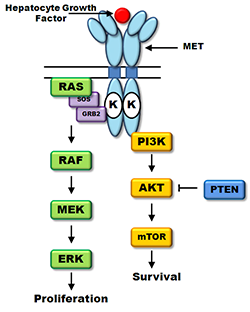MET
Official symbol
MET
Official full name
MET proto-oncogene, receptor tyrosine kinase
Gene ID
4233
Gene type
-
Other name
AUTS9,DFNB97,HGFR,RCCP2,c-Met
Gene location

Gene introduction
This gene encodes a member of the receptor tyrosine kinase family of proteins and the product of the proto-oncogene MET. The encoded preproprotein is proteolytically processed to generate alpha and beta subunits that are linked via disulfide bonds to form the mature receptor. Further processing of the beta subunit results in the formation of the M10 peptide, which has been shown to reduce lung fibrosis. Binding of its ligand, hepatocyte growth factor, induces dimerization and activation of the receptor, which plays a role in cellular survival, embryogenesis, and cellular migration and invasion. Mutations in this gene are associated with papillary renal cell carcinoma, hepatocellular carcinoma, and various head and neck cancers. Amplification and overexpression of this gene are also associated with multiple human cancers. [provided by RefSeq, May 2016].The MET gene (MNNG-HOS transforming gene; Cooper et al. 1984) located on chromosome 7, encodes a receptor tyrosine kinase (RTK) belonging to the MET/RON family of RTKs. Binding of its ligand, hepatocyte growth factor (HGF; also called scatter factor (SF)), induces a conformational change in the MET receptor that facilitates receptor phosphorylation and activation. Activated MET then phosphorylates its substrates, resulting in activation of multiple downstream pathways within the cell, including the PI3K-AKT-mTOR pathway, which is involved in cell survival, and the RAS-RAF-MEK-ERK pathway, which is involved in cell proliferation (Figure 1). In the context of malignancy, aberrant signaling through the MET receptor promotes pleiotrophic effects including growth, survival, invasion, migration, angiogenesis and metastasis.
Cancer pathway
The main pathways: Schematic of the MET signaling pathway. Growth factor binding to MET results in activation of the MAPK signaling pathway (RAS-RAF-MEK-ERK) and the PI3K pathway (PI3K-AKT-mTOR). The letter "K" within the schema denotes the tyrosine kinase domain.

Related to cancer
The MET receptor and/or its ligand HGF have been reported to be aberrantly activated in many human cancers (see http://www.vai.org/met/). Germline mutations in the tyrosine kinase domain of MET occur in 100% of hereditary papillary renal cell carcinoma, and somatic mutations in MET are found in 10–15% of sporadic papillary renal cell carcinoma. Mutations in MET have been reported at low frequencies in head and neck squamous cell carcinoma, childhood hepatocellular carcinoma, NSCLC and small cell lung cancer . Amplification of MET has been reported in gastric cancer , esophageal cancer , colorectal cancer, gliomas. clear cell ovarian cancerand NSCLC.
Alteration in cancer
| Gene | cDNA change | Protein change | Location |
|---|---|---|---|
| No data available. | |||
Related drugs in cancer
| Drug name | Other name | Product name | Type | Groups |
|---|---|---|---|---|
| No data available. | ||||